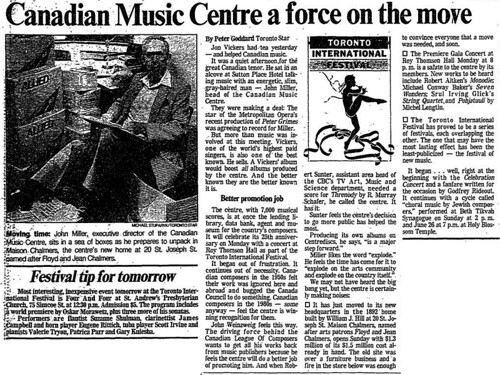This installment of my "Ghost City" column for The Grid was originally published on November 6, 2012.
Creating more space within a heritage building can be tricky, especially if plans outlining previous changes are unavailable. When the
Canadian Music Centre wanted to open up its main floor for a performance space and lounge, architects worked around obstacles like central-air ducts installed over the course of the former Victorian home’s history.
From its early days, 20 St Joseph St. provided a support centre for the arts. It was built in 1892 by William J. Hill, a contractor who served as a city councillor throughout the Naughty Nineties. Around 1894, it became the home of John S. Williams, who rose through the ranks of the tobacco industry to become chief inspector for Imperial Tobacco. According to a friend, Williams “was not a man who ever desired to be wealthy, and he felt that a generous portion of each year’s income should be spent on the arts.” Williams filled the walls and cupboard shelves with fine art, some of which was exhibited in European galleries. While the heart of his collection was Dutch School, Williams championed young Canadian artists through encouragement, organizing exhibitions, and enticing his wealthier friends to buy their work.
 |
| Toronto Star, April 8, 1921. |
Following Williams’ death in April 1921, the house passed to his daughter Grace Tremain. City directories indicate she split the residence into three apartments, including one for herself. A 1931
Star classified offered an “attractive, five-roomed heated and equipped apartment, fireplace, eight closets, two balconies” for $60 per month. Tremain resided at 20 St. Joseph St. until World War II, after which the three apartments housed a succession of tenants. By the late 1970s, residents of the apartment buildings surrounding 20 St. Joseph St. complained about the expansion of Yonge Street’s nightlife onto their street. Issues included noise and rowdiness from all-night clubs and discos, rooming houses of questionable repute, and teenage male prostitution.
Enter the Canadian Music Centre, an organization dedicated to promoting and preserving the work of Canadian composers. In September 1983, it announced a move from cramped quarters on Bay Street with questionable fire-safety standards to 20 St. Joseph St. The building was renamed Chalmers House in honour of patrons
Floyd and Jean Chalmers, who had also contributed critical support to local institutions ranging from the Canadian Opera Company to the National Ballet. Floyd Chalmers had risen rapidly in the journalism business, becoming editor of the
Financial Post by age 27 and president of Maclean-Hunter publications in his early 40s. He placed strong faith in the artists and organizations he supported, often telling them “I’m no good at this, but you are—so use your own judgement.”
 |
| Renovations to 20 St. Joseph Street, circa 1984. Image courtesy Canadian Music Centre. |
After several months of renovations designed by architect Raymond Moriyama (Ontario Science Centre, Toronto Reference Library), Chalmers House opened on June 24, 1984. The occasion was celebrated with a concert at Roy Thomson Hall where five compositions debuted.
 |
| Toronto Star, June 20, 1984. Click on image for larger version. |
The most recent round of renovations, designed by B+H Architects, simultaneously opened up the space and reintegrated historical features like fireplaces. Drop ceilings were removed and interior walls were sandblasted. Small offices gave way to a performance space that can seat up to 50, a recording studio, and a lounge in which musicians and the community can gather. Based on reactions from the official unveiling last week, the brighter, roomier space appears to be music to the ears of employees and musicians.
Additional material from the April 9, 1921 edition of the Globe, the June 23, 1984 edition of the Globe and Mail, and the April 8, 1921, April 24, 1931, and June 26, 1984 editions of the Toronto Star.





Comments